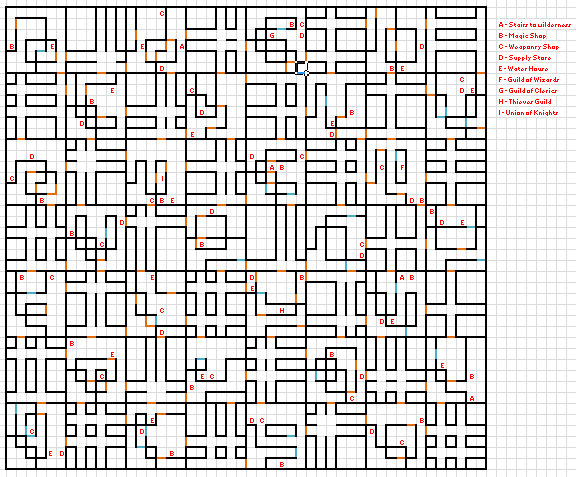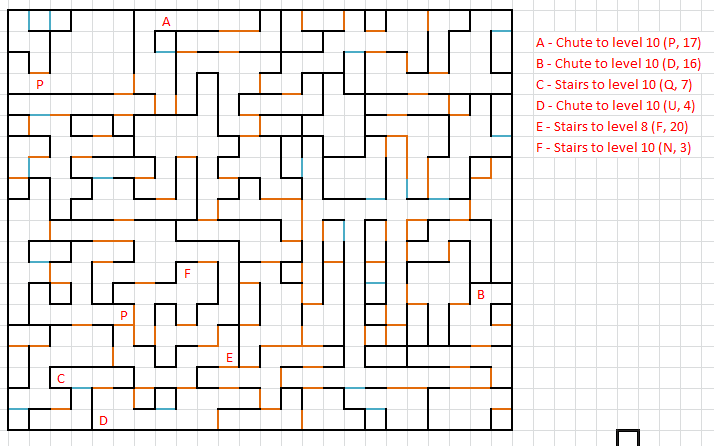With Orthanc done and dusted, it's time for me to move on to yet another game from 1975, and yet another game from the PLATO system: Moria. Moria was created at the University of Illinois by Kevet Duncombe and Jim Batton, both of whom claim that they had never heard of Dungeons & Dragons or read Tolkien at the time of the game's creation. The game was supposedly developed after they heard stories about the creation of The Game of Dungeons. I suppose I have to take their word for it, but I do find it a stretch that someone who has never read Tolkien would just pick the name Moria out of thin air. That they never played Dungeons & Dragons is more believable, because it doesn't play much like D&D at all.
The game begins with a pretty nifty title screen. Astute readers will notice that it's in colour, rather than the good old orange and black of the other PLATO games. My PLATO emulator has a colour option, and for this game I decided to try it out. I'm glad I did, because it makes the various elements of the game screen stand out from each other. I don't know if it's authentic, but it's certainly easier on the eyes (if a little garish).
The previous three games I've played (The Dungeon, Orthanc and The Game of Dungeons) were all top-down and icon-based, but Moria uses a first-person perspective. The land of Moria is depicted as a vast wire-frame maze, viewed through a teeny-tiny window. Seriously, look at the thing. It's so small.
The game, like most others of its type, involves wandering the maze, fighting monsters and gathering treasure. I'm not certain that it has an end-point, but there are a number of goals to strive for. The simplest is to get your name in the Hall of Fame, which is simply done by scoring a lot of points for killing monsters. My character, shown above, has 125 points, and will need over 19,133 to get in the Hall of Fame. If I want to get to the top, I'll need 8,590,248, which doesn't seem a likely scenario. The second goal is to become master of a guild, which is done by raising your stats and donating shedloads of gold; there are four guilds that you can join, and I'll discuss them further below. The last goal, and probably the most difficult, is to find the Reaper's Ring. When the game first started the ring was apparently found on the first level of one of the four "terrains" (dungeons, in other words). Every time the ring is found it drops down a level. It was last found on level 38, which means that I have a hefty task ahead of me.
Character creation is very simple. Every character has four stats: Cunning, Piety, Valor and Wizardry. All four range between 1 and 100, but the highest a stat can be when you start is 10. Cunning aids with tricking monsters and opening chests. Piety comes into play when you pray for aid. Valor helps you in combat, and determines what weapons you can use. Wizardry is used for casting spells. They aren't randomly determined at character creation. Instead you choose which stat will be your highest (with a value of 10), which also determines your medium stats (7) and your lowest stat (5). For my current character I chose a high score in Valor, which meant that I started with medium Cunning and Piety, and low Wizardry. It's the closest you get in the game to choosing a class, at least during character creation. Joining a guild gives you further, more specialised abilities, but more on that later. Your stats increase as you use them, but not very quickly. The character shown above is the result of a few hours of play, and he's only increased a few points in each score.
In addition to the four stats, you have Vitality, which starts at 100. When your Vitality drops to 0 you're dead, and it gets knocked down by the usual things: monsters and traps, mostly. Another thing that lowers your Vitality is starvation, as well as thirst, because this is a game where you have to make sure you have food and water. Without them you slowly die. The final thing that drains your Vitality, and the one that has affected me the most, is spellcasting. There's no limit to the number of spells you can cast, but each casting lowers your Vitality, so it's not wise to go around blasting spells everywhere.
The game takes place in the land of Moria, which is explicitly said to be an underground maze of rooms and corridors. This makes a certain sense, because the game is entirely composed of wireframe walls; drawing a tree was well beyond its capabilities. The game is structured as follows:
You begin the game in the city, which is a safe haven from monsters. It's also friggin' huge. All of the maps are divided into 6x6 blocks, and the city is eight blocks by seven blocks. That makes it 48x42 squares. The size of it wouldn't be a major problem, except that there's nothing to find. Sure there are weapon shops, and magic shops where you can sell stuff, and food shops, and water houses. But no matter how many weapon stores you find, they're all the same. The map is massive. I lost two characters to starvation just mapping the damn thing.
The size of the city is absurd given what's in it, and the only purpose it serves is to make it more difficult to find the four guilds.
I suppose I should talk about the guilds now. They are the Thieves Guild, the Brotherhood, the Union of Knights and the Circle of Wizards. Each corresponds to one of your stats, and you can only join the guild when that stat reaches 20. I haven't gotten that far yet, so I don't have any first hand knowledge of what they provide. According to the documentation each guild confers a special ability: members of the Brotherhood can heal; members of the Circle of Wizards can teleport back to the city; members of the Union of Knights take less damage and have a chance to behead monsters with a single blow; and members of the Thieves Guild have a better chance of finding magic items. In addition to this your character can have a guild locker, and if you die and create another character instantly, the contents of that locker will be passed to him as an heir. Your character starts at the age of 13, which makes the idea of having an heir a dubious one, but you know, medieval times.
I'm not sure what the Magic Shops are good for. You can't buy anything there, and although you can sell items, you can also do so at the Weaponry Shop. Perhaps you get better prices, but I haven't tested that out yet. The Supply Store is where you buy food, at the rate of 100 gold pieces for a month's worth. Water can be bought at the Water House, at the rate of 20 gold a month.
The most interesting shop, though, is the Weaponry Shop. The range of items available here is staggering. They're split into five categories: one-handed weapons, two-handed weapons, armor for the body, armor for the arms, and armor for the head. Each item has an Offensive Rating and Defensive Rating, and you can easily find these out by asking the shopkeeper. That's not all you can ask the shopkeeper, either. You can tell him what category you're looking for, and how much you want to spend, and he'll recommend something. You can also haggle. No matter what the starting price of the item, you can usually talk him down to about 2/3 of that total.
That's it for this week. I haven't progressed very far into the game as yet; I've mapped the city and the wilderness, and I'm just starting on the "Forest" (actually made of green tunnels and rooms). I'll be back next time to talk about the wilderness, and combat.









